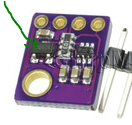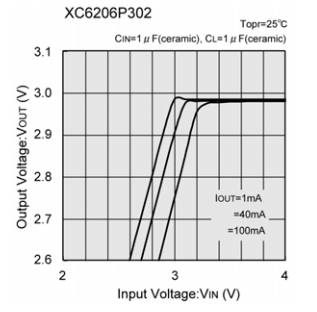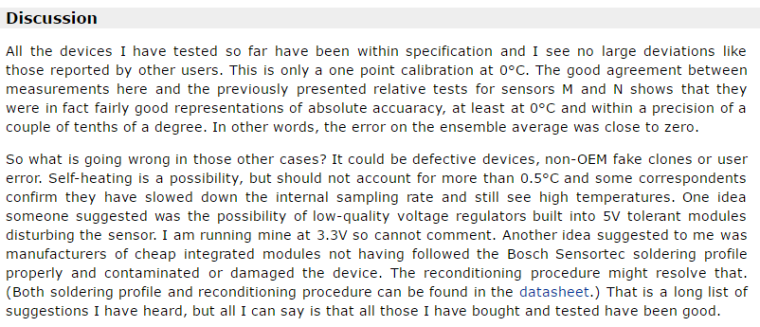BME280 Temp/Hum sensor on battery power increasingly skips(?) operation
-
I had problem that BME is inaccurate outside , I'm using BME180 and BME 280 both works great inside readings are almost same , but when I put it outside temperature is much higher than real, I compare it with ds18b20 or with my standalone weather station + local weather station , it was almost same but BME is higher about 2 degrees
@warmaniac yeah I think my BME280 is about +2 F than real temp. Anyway, do you have any suggestions as to resolving the issue? Maybe I should just replace it with DHT22.
-
@warmaniac yeah I think my BME280 is about +2 F than real temp. Anyway, do you have any suggestions as to resolving the issue? Maybe I should just replace it with DHT22.
I had 5 pcs of DHT 11 and 3 pcs of DHT22 and there are seriously piece of sh.. :) humidity readings was very bad only temperature okay , than if you want to measure only temperature best way is buy waterproof ds18b20 , https://www.ebay.com/itm/112029570094
-
@warmaniac yeah I think my BME280 is about +2 F than real temp. Anyway, do you have any suggestions as to resolving the issue? Maybe I should just replace it with DHT22.
@gogopotato Taken from the BME280 datasheet: "Temperature measured by the internal temperature sensor. This temperature value depends on the PCB temperature, sensor element self-heating and ambient temperature and is typically
above ambient temperature. " (does not explain very much ;-)) I have a good experience with this sensor when operated from a stable power source (3.3V ldo).
Some boards of the boards sold are equiped with a LDO which can cause problems if you operate under a certain voltage.
-
@gogopotato Taken from the BME280 datasheet: "Temperature measured by the internal temperature sensor. This temperature value depends on the PCB temperature, sensor element self-heating and ambient temperature and is typically
above ambient temperature. " (does not explain very much ;-)) I have a good experience with this sensor when operated from a stable power source (3.3V ldo).
Some boards of the boards sold are equiped with a LDO which can cause problems if you operate under a certain voltage.
I had this one, is it OK ? I power it directly from 2xAA batteries, and can operate 1,71 to 3,7 volts as I saw in datasheet .Then you said that is problem of using because it has self heating problem ?
-
@gogopotato Taken from the BME280 datasheet: "Temperature measured by the internal temperature sensor. This temperature value depends on the PCB temperature, sensor element self-heating and ambient temperature and is typically
above ambient temperature. " (does not explain very much ;-)) I have a good experience with this sensor when operated from a stable power source (3.3V ldo).
Some boards of the boards sold are equiped with a LDO which can cause problems if you operate under a certain voltage.
@AWI This is the BME280 module I'm using, and looks like it's got an LDO built-in, am I correct? Vin is 1.8 - 5V DC. Maybe I should just bypass the voltage booster and supply power to the module directly from the battery...?
-
I had this one, is it OK ? I power it directly from 2xAA batteries, and can operate 1,71 to 3,7 volts as I saw in datasheet .Then you said that is problem of using because it has self heating problem ?
@warmaniac That is the one without LDO (regulator). The self heating problem is not likely to occur if you are not constantly accessing the sensor and thus warming it. The main function of the temperature sensor is compensation for barometer and humidity reading. It is a rather complicated component with a lot of different settings and adjustments.
-
@warmaniac That is the one without LDO (regulator). The self heating problem is not likely to occur if you are not constantly accessing the sensor and thus warming it. The main function of the temperature sensor is compensation for barometer and humidity reading. It is a rather complicated component with a lot of different settings and adjustments.
-
I had this one, is it OK ? I power it directly from 2xAA batteries, and can operate 1,71 to 3,7 volts as I saw in datasheet .Then you said that is problem of using because it has self heating problem ?
@gogopotato And that one is with the LDO built in. You need to make sure that the sensor gets enough juice. I can't see which regulator is used but probably a 662K (XC6206) which is not likely to produce any voltage below 2.6V

-
I understand but it's mysterious thing , because indoor it works ok , but when I put it outside , readings are not correct , maybe it is not for outdoor usage :(
@warmaniac The sensor should be perfect for outdoor usage. At least you are not alone :relieved: . This guy deserves some real credits doing the research and has some ideas on the cause in the article. (you can also take look at his wedding pictures :wedding: there)
conclusion:

-
@warmaniac The sensor should be perfect for outdoor usage. At least you are not alone :relieved: . This guy deserves some real credits doing the research and has some ideas on the cause in the article. (you can also take look at his wedding pictures :wedding: there)
conclusion:

Thanks , I take a read after I finish in work. But I decided to use ds18b20 sealed version plus standalone humidity sensor , maybe it will be better :) Then I post some experiences. Maybe you can take a look on my photos too , I like landscapes photos , but sometimes I shooting weddings too :) www.pinak-art.com
-
My BME280 is around 1F hotter outside than a DS18B20 outside in another project. Not a big deal but I am also researching how to keep it cool. The library I am using is this one.
